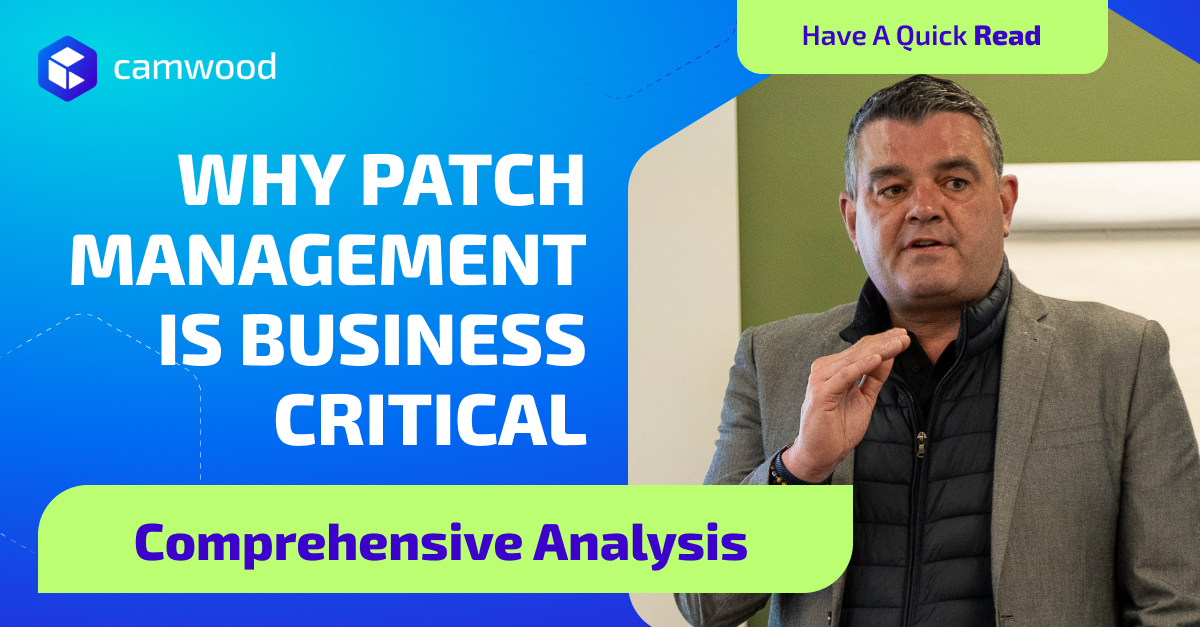Your patch approval committee meets every Tuesday at 10am. Critical vulnerability announced Monday afternoon? You're exposed for 6 days minimum.
This is the patch management paradox facing organisations today: Security demands speed, but governance requires process.
With cyberattacks increasing by 125% year-over-year and 95% of successful breaches exploiting known vulnerabilities, understanding and implementing effective managed patch management strategies has never been more crucial for enterprise success.
This guide explores everything you need to know about modern patch management in 2025, from fundamental concepts to advanced automated patch management strategies that protect your organisation whilst optimising operational efficiency.
What is Patch Management?
Patch management is the systematic process of identifying, acquiring, testing, and deploying software updates across an organisation's IT infrastructure to address security vulnerabilities, fix bugs, and improve system performance whilst maintaining business continuity.
Patch management is the systematic process of identifying, acquiring, testing, and installing software updates (patches) across an organisation's IT infrastructure.
These updates address security vulnerabilities, fix bugs, improve performance, and add new functionality to operating systems, applications, and firmware. In the enterprise context, enterprise patch management extends beyond simple software updates to encompass comprehensive lifecycle management that includes:
- Vulnerability management and risk prioritisation
– Using threat intelligence to patch actual risks, not vendor noise
- Patch testing and compatibility validation
– Automated testing environments that validate patches against your specific configuration
- Deployment scheduling and rollback planning
– Phased approaches with pilot groups, canary deployments, and one-click restoration
- Compliance monitoring and audit reporting
– Real-time dashboards and automated audit trails that transform compliance from burden to competitive advantage - Performance tracking and success measurement
– Clear, measurable KPIs defined at project inception
How Does Patch Management Work?
Modern patch management processes follow a systematic approach that ensures security without compromising operations:
1. Discovery: Identify all assets across your IT environment
2. Assessment: Evaluate vulnerabilities and prioritise based on risk
3. Testing: Validate patches in controlled environments
4. Deployment: Roll out patches using business-aware strategies
5. Verification: Confirm successful installation and compliance
6. Reporting: Maintain audit trails for regulatory requirements
This six-stage process forms the foundation of effective enterprise security management.
The Evolution of Patching in 2025
Modern patch management services have evolved significantly from manual, schedule-driven approaches.
Today's intelligent patch management systems leverage artificial intelligence, machine learning, and automated workflows to deliver:
Proactive Threat Prevention: Advanced systems now predict and prevent security incidents rather than simply responding to them. Automated patch management platforms analyse threat intelligence feeds, vulnerability databases, and business context to prioritise patches based on actual risk rather than vendor timelines.
Last week, when a zero-day emerged in widely-used collaboration software, organisations with intelligent systems had their most vulnerable systems protected within 3 hours. Automatically.
Business-Aware Deployment: Modern solutions understand operational requirements and business priorities, ensuring critical systems remain available whilst maintaining security. Patching automation adapts to your organisation's workflows, peak usage periods, and maintenance windows.
Continuous Compliance Monitoring: Today's patch management solutions provide real-time compliance dashboards, automated audit trails, and regulatory reporting for GDPR, ISO 27001, NIST 800-53, SOC 2, and industry-specific mandates.
→ Ready to assess your current patch management approach? Explore intelligent automation solutions that transform security from burden to competitive advantage.

Why is Patch Management Important?
The Rising Threat Landscape
Security Vulnerabilities Increase Exponentially
The volume of discovered vulnerabilities has grown dramatically, with over 25,000 new Common Vulnerabilities and Exposures (CVEs) reported in 2024 alone (Source: NIST National Vulnerability Database, 2024).
This represents a 15% increase from the previous year, highlighting the accelerating pace of security threats.
Zero-Day Exploits Become Mainstream
Zero-day patch deployment is now released weekly rather than monthly, requiring organisations to respond within hours rather than days.
The average time between vulnerability disclosure and active exploitation has decreased to just 15 days (Mandiant Threat Intelligence Report, 2024), making rapid patch deployment critical for security.
Ransomware Targets Unpatched Systems
85% of ransomware attacks specifically target known vulnerabilities that have available patches (Verizon Data Breach Investigations Report, 2024).
The average ransomware payment now exceeds £850,000, not including business disruption, reputation damage, and regulatory fines.
Business Impact of Ineffective Patching
Financial Consequences
Organisations with poor patch management practices face average annual losses of £2.4 million from security incidents.
One financial services firm discovered they were spending £580K annually just to keep 5,000 devices patched:
- £180K in licensing for three overlapping tools
- £350K in labour (5 FTEs spending 60% of time on patching)
- £50K+ in annual incident response from preventable breaches
By implementing managed patch services at £180K annually, they achieved the same security outcomes with a 69% cost reduction.
Operational Disruption
Manual patch management problems typically achieve only 60-70% compliance rates whilst consuming 30-40% of IT administrator time.
This creates a vicious cycle where security gaps widen whilst IT teams struggle to maintain basic operational requirements.
Third-party application patching consumes 15 hours weekly of most teams' time. Windows updates? Just 3 hours.
Yet most organisations focus automation efforts on Windows whilst manually managing Adobe, Java, browsers, and thousands of other applications.
Regulatory and Compliance Risks
Modern frameworks including GDPR, NIS Directive, and industry-specific regulations explicitly require demonstrable patch management processes.
Patch management for compliance has become non-negotiable, with non-compliance fines averaging £890,000 in the UK, with some reaching tens of millions for repeat offenders.
Core Components of Effective Patch Management
1. Comprehensive Asset Discovery and Inventory
Automated Asset Detection
Modern enterprise patch management services begin with complete visibility into your IT environment.
Advanced discovery tools identify all devices, operating systems, applications, and firmware across on-premises, cloud, and hybrid infrastructures – typically completing estate mapping within one day rather than months.
One organisation discovered 47 different PDF readers across just 400 people. Another found 847 applications when they expected around 300.
You can't patch what you can't see.
Real-Time Inventory Maintenance
Static inventories become outdated within days in dynamic enterprise environments.
Continuous monitoring ensures patch management systems maintain accurate, real-time visibility into your infrastructure changes and new asset deployment.
Shadow IT Identification
Unauthorised applications and devices present significant security risks.
Advanced discovery capabilities identify shadow IT installations, bringing them under management and eliminating hidden vulnerability exposure.
2. Intelligent Vulnerability Assessment
Risk-Based Prioritisation
'We have 200 vulnerabilities marked critical. Which do we patch first?'
This is the reality every security leader faces: Vendors mark everything 'critical.' Security scanners flag hundreds of issues.
But your team can't patch everything simultaneously without bringing the business to a halt.
Vulnerability prioritization patch management systems analyse multiple factors including:
- Common Vulnerability Scoring System (CVSS) ratings – Technical severity scores
- Threat intelligence indicating active exploitation – What's actually being used by attackers right now
- Business criticality of affected systems – Which systems matter most to your operations
- Potential impact on operations and data – Realistic assessment of consequences
Real-time threat intelligence integrated with CVSS scoring and business context means patching by actual risk to your specific environment, not vendor noise.
Contextual Risk Analysis
Modern vulnerability management systems understand your specific environment, considering factors such as network segmentation, access controls, and compensating security measures when prioritising patch deployment.
Predictive Threat Modelling
Machine learning algorithms analyse historical attack patterns, current threat intelligence, and environmental factors to predict which vulnerabilities pose the greatest risk to your specific organisation.
3. Automated Testing and Validation
Compatibility Testing
Software patching often introduces compatibility issues that can disrupt business operations.
Automated testing environments validate patches against your specific configuration before deployment, identifying potential conflicts.
Three weeks ago, one security team manually scored each vulnerability against their risk matrix. It took 6 days.
During that time, three of those 'critical' vulnerabilities were actively being exploited in the wild.
Performance Impact Assessment
Patches can affect system performance in unexpected ways.
Automated patch management tools measure resource utilisation, response times, and throughput to ensure patches don't degrade user experience.
Rollback Planning
Every patch deployment should include automated rollback capabilities.
Modern systems create system snapshots, maintain rollback procedures, and provide one-click restoration if issues arise.
4. Intelligent Deployment Strategies
Progressive Rollout Approaches
Rather than enterprise-wide deployment, modern automated patch management uses phased approaches:
- Pilot groups for initial validation – Test with representative sample first
- Canary deployments for gradual expansion – Slowly increase coverage while monitoring
- Blue-green deployments for zero-downtime updates – Maintain parallel environments
- Rolling deployments for high-availability systems – Update incrementally without service interruption
Business-Aware Scheduling
Deployment schedules consider business operations, peak usage periods, and maintenance windows.
AI powered patch management optimises deployment timing to minimise business impact whilst maintaining security.
Emergency Response Protocols
The zero-day announcement came through at 4:47pm Friday. 8,000 endpoints needed patching before Monday morning.
Zero-day patch deployment requires immediate deployment capabilities.
Emergency protocols enable rapid deployment whilst maintaining safety measures and rollback capabilities – protecting vulnerable systems within 3-4 hours rather than days.
→ Concerned about your zero-day response time? Discover how intelligent automation delivers 3-4 hour protection vs days with traditional approaches.
Types of Patches in Patch Management
Operating System Patches
Security Updates
These address identified security vulnerabilities in the operating system core, kernel, or system services. Security patches typically receive the highest priority due to their potential for widespread impact.
Windows Patch Management
Windows patch management has evolved significantly with Windows 11, introducing advanced security capabilities including hardware-based isolation, enhanced encryption, and zero-trust architecture that significantly enhance security posture.
Feature updates add functionality, improve performance, or modify user interfaces, whilst cumulative updates combine multiple fixes and improvements for streamlined deployment.
Application Patches
Third-Party Application Updates
Third-party application patching covers business applications from vendors like Adobe, Microsoft Office, browsers, and industry-specific software requiring regular updates for security and functionality improvements.
One manufacturing client reduced patch management time from 15 hours to 2 hours weekly through automation.
That's 676 hours returned annually per team member – capacity they redirected to Windows 11 migration planning.
Same team, dramatically different outcomes.
Custom Application Patches
Internally developed applications require specialised patching approaches that coordinate with development teams and change management processes as part of application lifecycle patch management.
Browser and Plugin Updates
Web browsers and plugins represent common attack vectors requiring frequent updates.
Automated browser patching prevents exploitation of web-based vulnerabilities.
Firmware and Driver Updates
Hardware Firmware
Network devices, servers, and endpoint hardware require firmware updates to address security issues and improve functionality.
These updates often require specialised procedures and potential system restarts.
Device Drivers
Operating system drivers for hardware components require regular updates to maintain compatibility, security, and performance.
Driver updates must be carefully tested to prevent system instability.
Patch Management Best Practices
With 25 years of expertise in IT transformation, leading organisations use proven methodologies that go beyond applications to deliver comprehensive security and operational excellence.
The FUSION Framework: A Proven Patch Management Strategy
1. Find and Frame
Comprehensive assessment of your current patch management capabilities, identifying gaps, inefficiencies, and risk exposure across your IT environment.
This includes understanding which systems and applications pose the greatest risk to your organisation.
2. Utilise Insights
Leveraging data analytics, threat intelligence, and extensive experience to develop a modernisation patch management strategy that aligns with your business values and unlocks innovation potential across your entire organisation.
3. Service Delivery
Executing the modernisation plan using proprietary tools and methodologies, ensuring minimal disruption to operations whilst maximising the impact of transformation beyond just applications.
4. Identify and Innovate
Continuously seeking opportunities for innovation, particularly in integrating AI in patch management and automation.
This ensures your modernised IT landscape is future-ready for emerging technologies.
5. Operationalise Outcomes
Ensuring modernised applications and processes are deeply embedded in operations, with focus on enhancing user experiences and driving business value throughout your organisation.
6. Normalise and Nurture
Post-modernisation support to standardise best practices and foster a culture of continuous improvement, setting the stage for ongoing innovation.
Common Patch Management Challenges and Modern Solutions
Challenge 1: Resource Constraints and Skills Gaps
The Problem
Many organisations lack sufficient skilled personnel to manage complex patching requirements whilst maintaining other IT responsibilities.
Manual patch management consumes disproportionate time whilst achieving inadequate results.
One IT Director's team achieved only 60-70% compliance rates whilst spending 30-40% of their time on patching.
When asked, 'What percentage of patches actually need manual intervention?', her honest answer: 'Maybe 5%?'
Modern Solutions
Managed patch management services provide expert resources and advanced automation without requiring internal staff expansion.
Those 5 FTEs? They're now working on cloud migration, security architecture, and Windows 11 planning.
Patch management cost reduction: 87% reduction in manual effort. 71% reduction in IT costs. Same security outcomes.
Implementation Approach
Hybrid models combine internal oversight with external expertise through patch management consulting, providing knowledge transfer whilst ensuring immediate capability improvement.
Challenge 2: Business Continuity Requirements
The Problem
Critical business systems cannot tolerate downtime for maintenance, creating tension between security requirements and operational availability.
Modern Solutions
Advanced patching automation enables zero-downtime deployments through live patching, rolling updates, and sophisticated failover mechanisms.
Implementation Approach
Risk-based deployment strategies prioritise critical systems whilst maintaining business availability through intelligent scheduling and redundancy planning.
Challenge 3: Compliance and Audit Requirements
The Problem
Regulatory frameworks require comprehensive documentation, audit trails, and compliance demonstration that manual processes struggle to provide consistently.
Modern Solutions
Patch management compliance automation provides real-time dashboards, complete audit trails, and regulatory reporting that transforms compliance from a burden into a competitive advantage.
One CISO discovered 47 applications across acquired tenants that were past end-of-life. Three had critical vulnerabilities actively being exploited in the wild.
The organisation had no idea they existed.
Result: Potential £4.2M GDPR fine avoided.
Implementation Approach
Integrated compliance platforms combine patch management with broader security governance, providing holistic compliance management and reporting for GDPR, ISO 27001, NIST 800-53, SOC 2, and industry-specific mandates.
→ Struggling with manual processes?
Explore how 200+ enterprises achieved 95%+ compliance rates with intelligent automation.
Application Intelligence: ALICE Platform
Key Capabilities
Rapid Discovery and Assessment
- 95% faster application discovery and cataloguing versus manual methods
- Complete estate mapping within one day rather than months
- Typical client result: Discovered 847 applications, planned migration in 3 weeks
Intelligent Prioritisation
- Automatically map every application and identify hidden security risks
- Integration with Microsoft Defender for Endpoint for complete application vulnerability visibility
- Risk scores and impact-based security response
- Affected device tracking
Automated Decision Support
- Clear recommendations: keep, consolidate, or remove
- Usage pattern analysis
- Business impact assessment
- 25 years of ALM expertise embedded in every recommendation
Real-World Impact
One financial services firm acquired three regional competitors, resulting in application chaos across four Microsoft 365 tenants.
Before intelligent application management:
- 6 months manual discovery
- 1,847 applications (rough count)
- £4.2M duplicate spending
- 18-month consolidation estimate
- Unknown security posture
After implementation:
- Complete inventory in one day
- 1,847 applications precisely catalogued
- 90% immediate reduction potential identified
- Consolidated to 186 standardised applications
- 3-month actual completion timeline
- £2.9M annual cost savings
- Full security compliance achieved
- ROI: 8,700% in first year
Future Trends in Patch Management
Artificial Intelligence and Machine Learning
Predictive Patch Prioritisation
AI in patch management systems analyse threat intelligence, environmental factors, and historical patterns to predict which vulnerabilities pose the greatest risk to specific organisations.
By 2025, 70% of new applications use low-code or no-code technologies, many incorporating AI capabilities (Gartner, 2024).
Automated Decision Making
Machine learning algorithms make increasingly sophisticated decisions about deployment timing, testing requirements, and rollback triggers based on continuous learning from deployment outcomes.
Intelligent Resource Optimisation
AI-powered patch management optimises resource allocation, network bandwidth usage, and system performance during patch deployment to minimise business impact.
Cloud-Native and Container Technologies
Immutable Infrastructure
Cloud native patch management enables 'patching' through complete image replacement rather than traditional update mechanisms, improving reliability and security.
Microservices Patching
Distributed architectures require new approaches that can update individual services without affecting entire applications or systems.
Edge Computing Considerations
IoT and edge devices create new challenges for patch distribution, testing, and management across geographically distributed and resource-constrained environments.
The edge computing market will grow to £43 billion by 2026 (IDC Forecast, 2024).
Zero Trust Security Integration
As cyber threats evolve, zero trust patch management architectures are becoming the norm.
Modernisation strategies need to bake in zero trust principles from the ground up, with patch management as a critical component of the IT security automation framework.
Getting Started: Building Your Patch Management Strategy
Initial Assessment and Planning
Current State Analysis
Begin with comprehensive assessment of existing patch management capabilities, identifying gaps, inefficiencies, and risk exposure across your IT environment.
Key questions to answer:
- What's your actual patch compliance rates?
- How much time does your team spend on patching weekly?
- What percentage of patches actually need manual intervention?
- How long does it take to respond to critical vulnerabilities?
- What's your total cost of patch management?
Risk Assessment and Prioritisation
Understand which systems and applications pose the greatest risk to your organisation, considering factors such as data sensitivity, business criticality, and threat exposure.
Resource and Budget Planning
Evaluate internal capabilities, budget constraints, and strategic priorities to determine the optimal approach for patch management improvement.
Implementation Roadmap
Phase 1: Foundation Building (Months 1-3)
- Complete asset inventory and vulnerability assessment
- Establish baseline security metrics and compliance status
- Implement basic automated patching for non-critical systems
- Develop policies and procedures for patch management
Phase 2: Capability Expansion (Months 4-6)
- Deploy advanced automation for business-critical systems
- Integrate threat intelligence and risk-based prioritisation
- Implement comprehensive testing and validation workflows
- Establish performance monitoring and reporting systems
Phase 3: Optimisation and Enhancement (Months 7-12)
- Fine-tune automation rules and deployment strategies
- Implement predictive analytics and AI-powered decision making
- Expand coverage to include firmware and specialised applications
- Achieve continuous compliance and audit readiness
Measuring Success: Key Performance Indicators
Effective patch management requires clear, measurable KPIs defined at project inception:
Security Metrics
- Patch compliance rates – Target: 95%+ for critical patches
- Mean time to patch (MTTP) – Critical vulnerabilities: Under 4 hours
- Vulnerability exposure window – Days between disclosure and remediation
- Security incident reduction – Year-over-year comparison
Operational Metrics
- IT time savings – Hours returned to strategic work
- Deployment success rates – Patches deployed without rollback
- System uptime – Availability during patching cycles
- User impact – Service disruption complaints
Business Metrics
- Cost reduction – Total cost of ownership comparison
- Compliance status – Audit readiness and regulatory adherence
- Risk exposure – Quantified vulnerability reduction
- Resource reallocation – Capacity redirected to innovation
Real Client Outcomes from Enterprise Patch Management
Financial Services Firm: Patch Management for Financial Services
Challenge: 5,000 endpoints, three overlapping patching tools, 60-70% compliance rates
Solution: Managed patch services with intelligent automation
Results:
- £580K to £180K annually (69% patch management cost reduction)
- 95%+ patch compliance rates
- 5 FTEs redirected to strategic initiatives
- Zero-day response time: Under 4 hours (previously 8-12 days)
[Read the full case study →] (Internal link: /case-studies/financial-services-patch-management)
Manufacturing Client: Manufacturing Patch Management
Challenge: 15 hours weekly on application patching, minimal Windows automation
Solution: Automated third-party application patching across 15,000+ business applications
Results:
- 15 hours to 2 hours weekly (87% time reduction)
- 676 hours returned annually per team member
- Capacity redirected to Windows 11 migration
- Same team, dramatically different outcomes
Aerospace Manufacturer
Challenge: 8,000 endpoints, 200 critical vulnerabilities, manual prioritisation taking 6 days
Solution: Intelligence-driven patching with real-time threat intelligence
Results:
- Vulnerability prioritisation: 6 days to hours
- Most vulnerable systems protected within 3 hours of zero-day disclosure
- Automated pilot group validation
- Maintained business continuity throughout
Working with Regulated Industries
With 25+ years supporting regulated industries including Finance, Engineering, Healthcare, and Manufacturing, proven approaches address the unique challenges of highly regulated, security-focused environments.
[Explore our services →] (Internal link: /services/application-lifecycle-management)
Industry-Specific Compliance
Patch Management for Financial Services
- PCI DSS requirements for payment systems
- FCA regulatory expectations
- Data protection and encryption standards
- Audit trail and documentation requirements
Patch Management for Healthcare
- HIPAA compliance for patient data
- Medical device patching considerations
- Clinical system availability requirements
- Data sovereignty and privacy regulations
Government Patch Management Requirements
- Security clearance and vetting requirements
- Air-gapped and classified network patching
- Cyber Essentials Plus certification
- NCSC guidance adherence
Manufacturing Patch Management
- OT/IT convergence challenges
- Production system uptime requirements
- Supply chain security considerations
- Industry 4.0 and IoT device management
Conclusion
Effective patch management in 2025 requires a fundamental shift from reactive, manual processes to proactive, intelligent automation that aligns with business objectives whilst maintaining robust security posture.
The complexity of modern IT environments, evolving threat landscape, and stringent regulatory requirements make traditional approaches inadequate for enterprise success.
The key lies in selecting solutions that provide:
- Comprehensive coverage – All applications, operating systems, and firmware
- Intelligent automation – AI-powered prioritisation based on actual risk
- Business-aware deployment – Maintaining availability whilst ensuring security
- Continuous compliance – Real-time dashboards and automated audit trails
- Measurable outcomes – Clear KPIs with demonstrated results
Organisations that embrace modern automated patch management achieve:
- 95%+ compliance rates without approval bottlenecks
- 69-87% cost reductions through intelligent automation
- 3-4 hour response times to zero-day threats
- 87% reduction in manual IT effort
- Enhanced security posture with reduced risk exposure
As cyber threats continue to evolve and regulatory requirements become more stringent, the question isn't whether to modernise your patch management approach—it's how quickly you can implement intelligent automation that protects your organisation whilst enabling business growth.
Next Steps
Don't let outdated patch management practices leave your organisation vulnerable to preventable security incidents.
Modern managed patch management solutions deliver immediate improvements in security posture whilst reducing operational overhead and compliance burden.
Assessment
Conduct a comprehensive audit of your current patch management effectiveness:
- What's your actual compliance rate?
- How much are you spending annually?
- What percentage requires manual intervention?
- How long to respond to critical vulnerabilities?
Planning
- Align patch management with broader business objectives
- Develop a business case highlighting potential ROI
- Identify quick wins and long-term capability building
- Create a phased implementation roadmap
Implementation
- Partner with experienced providers who understand enterprise patch management requirements
- Leverage proven methodologies and frameworks
- Ensure solutions integrate with existing infrastructure
- Plan for continuous optimisation and improvement
Measurement
- Define clear KPIs at project inception
- Implement real-time monitoring and reporting
- Regular reviews and optimisation
- Demonstrate value to stakeholders
Ready to transform your patch management approach?
Book a consultation →



